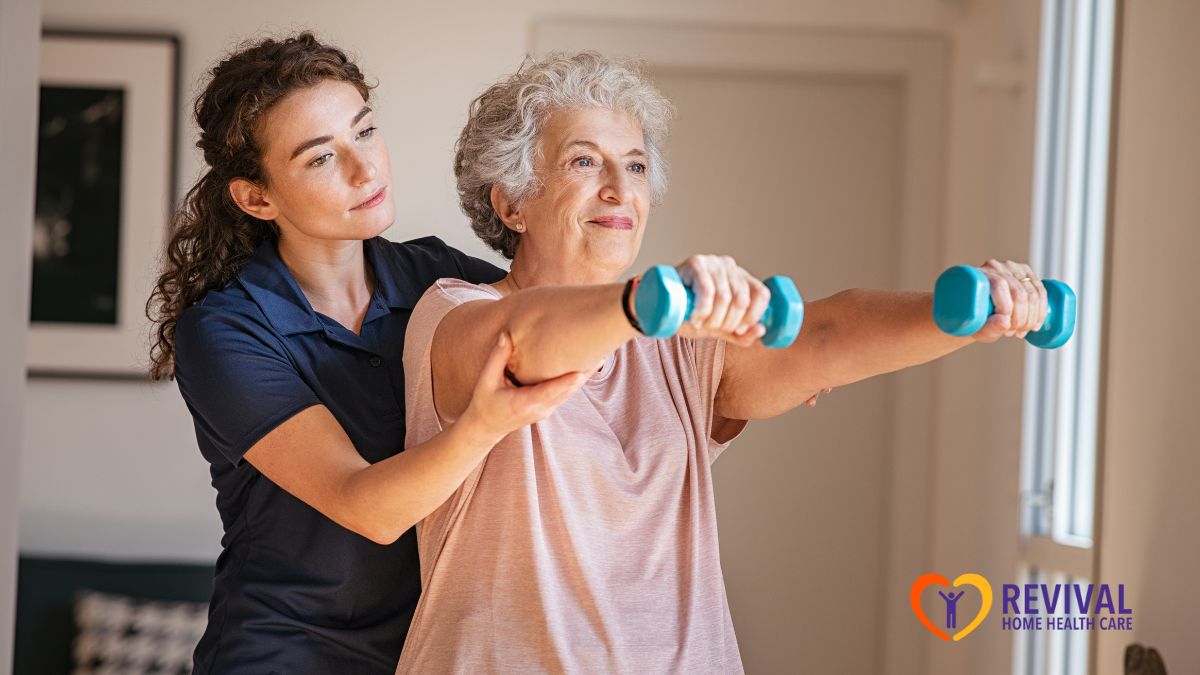Key Points:
- Stroke rehab at home follows a 30-day plan with daily routines for movement, hand practice, speech, and balance.
- Week 1 focuses on safety and setup, Week 2 on daily tasks, Week 3 on strength and endurance, and Week 4 on independence and community.
- Progress builds with consistent practice and caregiver support.
Stroke rehab at home involves structured daily routines that build mobility, strength, speech, and independence. Common steps include short walks, range-of-motion exercises, hand practice, and memory drills. These routines support recovery, reduce safety risks, and ease the transition from hospital to home.
A stroke changes daily life in a moment, and rehab can feel like a second full-time job. A simple, steady plan helps families know what to do each day. This 30-day guide lays out small steps that add up to progress. The focus stays on real-world tasks at home and tips that fit busy schedules.
 Stroke Rehab at Home: 30-Day Schedule Overview
Stroke Rehab at Home: 30-Day Schedule Overview
A home program works best when it blends short practice blocks, meaningful tasks, and rest. The core of stroke rehab at home includes five daily routines. Each routine can start small, then expand across the month.
- Morning body wake-up. Do light range-of-motion exercises and breathing practice, often started in physical therapy.
- Mobility minutes. Take short walks or use a wheelchair with posture checks.
- Hand and arm practice. Reach, grip, release, and handle simple objects.
- Speech and thinking time. Practice clear words, short phrases, and memory cues that align with speech therapy goals.
- Evening balance and calm. Try gentle standing exercises, then relax to wind down.
A strong plan also watches for safety. Falls, fatigue, swallowing safety concerns, and mood shifts are common after a stroke. One review found that about one in three stroke survivors experience depression, so caregivers should watch for low mood, loss of interest, and sleep changes and bring them up with a clinician.
National data shows that every year more than 795,000 people in the United States have a stroke, and stroke is a leading cause of serious long-term disability. These numbers show how common stroke is and why good home routines matter from week one.
Week 1: Setup, Safety, and Simple Wins
The first week sets the tone. The goal focuses on safe movement inside the home, basic self-care, and a calm daily rhythm. Stroke care at home starts with a walkthrough of the space and a short checklist for each room.
Daily focus for Week 1
- Home setup and safety. Draw on occupational therapy home modifications like clear walkways, secure lighting, and adaptive equipment. Post an emergency list near the phone.
- Medication and vitals fit under skilled nursing medication management. Use a pill organizer. Set phone reminders. Track blood pressure, pulse, and blood sugar if advised.
- Energy pacing. Follow a “10 minutes on, 20 minutes off” rhythm if fatigue runs high. Use a simple log to note times that feel best for movement and speech practice.
- Swallowing basics. Sit upright for meals. Take small bites. Tuck the chin slightly if instructed by your speech therapist. Stop and call your clinician if coughing, a wet voice, or chest discomfort appears during meals.
- Caregiver roles. Agree on a simple handoff plan for mornings and evenings. Decide who leads meds, meals, and transport.
Practice plan for Week 1
- Morning body wake-up. Gentle neck, shoulder, elbow, wrist, hip, and ankle range-of-motion on the bed or chair. Ten slow breaths with belly rise.
- Mobility minutes. Transfers with a gait belt if taught in in-home physical therapy. Short walks in a clear hallway with a cane or walker if prescribed.
- Hand and arm. Towel slides on a table. Pick up and place coins or buttons into a cup. Open and close clothespins.
- Speech and thinking. Read a short paragraph out loud. Name items in the room. Use a memory notebook for appointments and exercise steps.
- Evening balance and calm. Sit-to-stand from a chair. Heel-toe weight shifts at the counter. Three minutes of slow breathing before bed.
What to watch
- New weakness, a drooping face, slurred speech, or sudden confusion. Call emergency services
- Worsening shortness of breath during meals or while lying flat
- Sudden headache, chest pain, or vision loss
Week 2: Build Daily Routines Into Real Tasks
Week 2 uses daily life as the rehab gym. Stroke rehab at home grows stronger when practice fits household tasks. The goal centers on safer transfers, short walks, and light chores with built-in problem solving.
Daily focus for Week 2
- Transfer skills. Practice bed to chair. Practice toilet transfers using grab bars. Practice car transfers with the seat pushed back and reclined.
- Short walks with purpose. Walk to the mailbox. Walk to water plants. Walk the kitchen triangle between sink, fridge, and stove.
- Hand use in chores. Fold towels. Wipe a table with both hands on the cloth. Open snack bags with scissors and a stable cutting board.
- Speech in conversation. Use short scripts. Example: “I need a rest.” “Please repeat that.” “I want tea.”
- Cognitive warm-ups. Use a timer for 3 minutes to sort mail, match socks, or write a simple grocery list.
Practice plan for Week 2
- Strength steps. Wall push-ups. Mini-squats to a chair. Sidestepping along a counter.
- Home-based therapy for strength and balance basics. Feet together, standing with light support. Weight shifts forward and back. Marching in place holding the counter.
- Hand and arm. Reach to the top shelf with a light plastic cup. Move beans from one bowl to another with a spoon.
- Speech and thinking. Count change. Call a friend and share your three goals for the day. Do a simple word-finding game by naming five foods, five tools, and five places.
Motivation and mood
- Schedule one daily “win,” such as making coffee or feeding a pet.
- Set a five-minute timer twice a day for a mood check. Ask “What helped today” and “What felt hard.” A quick note builds insight and helps your team adjust the plan.
Week 3: Strength, Balance, Speech, and Endurance
Week 3 raises the challenge while keeping the plan safe. The goal expands to community practice, such as a short park walk or a grocery trip with support. Caregivers keep a close eye on fatigue, foot clearance, and attention in busy spaces.
Daily focus for Week 3
- Endurance blocks. Aim for two to three 10- to 15-minute movement blocks spread across the day if cleared by your clinician. All these pair well with telehealth services for check-ins and symptom monitoring.
- Advanced balance. Add turns, reaching outside your base, and stepping over a line of tape on the floor.
- Task complexity. Combine steps, such as standing to fold laundry while naming colors or counting items.
- Hand dexterity. Use therapy putty, rubber bands, and small pegs as part of occupational therapy for hand function. Practice zipper pulls and button hooks for clothing.
- Speech carryover. Practice phone calls to schedule an appointment, ask a store for hours, or confirm a ride. Use a notepad to write down the key details.
Practice plan for Week 3
- Strength circuit. Three rounds of sit-to-stand, wall push-ups, and step taps on a low step.
- Gait quality. Focus on a level gaze, heel-to-toe steps, and even stride length. Use a metronome app for a steady pace if advised.
- Upper limb practice. Reaching to three shelf heights with a light item. Opening and closing different containers from the pantry.
- Cognition and speech. Read a recipe out loud. Follow two-step directions. Tell a short story from a photo.
Why mental health belongs in Week 3
- A pooled analysis shows about 33% of survivors have depression, and more than half of those cases can persist across the first year if unaddressed. Early screening and simple routines like daily movement and social contact help.
Week 4: Independence, Community, and Long-Term Habits
Week 4 ties the plan together. The focus turns to doing more with less help. Stroke in home care grows into life outside the house, like a short family outing, a paid ride to a community center, or a calm visit with friends.
Daily focus for Week 4
- Household independence grows faster with home health aide support. Choose two self-care tasks and two home tasks to do with minimal help, such as showering on a seat, preparing a simple breakfast, taking out light trash, or changing pillowcases.
- Community trial. Plan one short trip. Pick a time with low crowds. Bring a list and a clear role for the caregiver.
- Stairs and curbs. Practice step-ups with a rail if cleared. Use the phrase “up with the strong leg, down with the weak leg” to remember safer patterns.
- Endurance test. Time a flat walk that feels steady. Write down the distance and rate of perceived exertion from 0 to 10.
- Plan the next 60 days. Keep what works. Drop what causes pain or unsafe fatigue. Add one new goal per month, such as getting in and out of a sedan without help or speaking clearly in a group.
Practice plan for Week 4
- Strength and balance combo. Sit-to-stand, step-throughs, and tandem stance near a counter.
- Dual-task walking. Walk while naming animals, months, or grocery items.
- Hands to real life. Practice wallet or purse management, keeping keys in the lock, and phone dialing with speed and accuracy.
- Speech in the community. Order at a café, ask for help finding an item, or confirm directions. Use short scripts to reduce stress.
When to ask for more help and review eligibility using our how to qualify for home health care in New York guide:
- If progress stalls for a week
- If falling, tripping, or near-falls appear
- If speech gets less clear or swallowing worsens
- If mood stays low most of the day
Large reviews of early supported discharge show shorter hospital stays by about five to six days on average and better odds of living at home and being independent at follow-up. These results align with heart failure home care that builds strong routines after discharge
 Frequently Asked Questions
Frequently Asked Questions
Can a stroke cause vertigo?
Yes. A stroke can cause vertigo, especially when it affects the posterior circulation. Stroke-related vertigo often appears with imbalance, abnormal eye movements, or vision or speech changes. Because it can mimic inner-ear disorders, continuous vertigo with neurological signs requires emergency evaluation with bedside tests and MRI.
What is the best way to recover from a stroke?
The best way to recover from a stroke is with early, intensive, task-specific rehabilitation guided by a team. Recovery programs combine mobility training, upper-limb exercises, speech and cognitive therapy, and caregiver education. Exercise begins when stable, and secondary prevention manages blood pressure, blood sugar, cholesterol, and smoking.
What activities should you avoid after a stroke?
After a stroke, avoid driving until cleared by a clinician, long flights in the first two weeks, and heavy lifting or intense exercise until blood pressure and heart status are reviewed. Skip high fall-risk tasks and hot baths to prevent injury. Resume sexual activity only after medical review and safety checks.
Choose Home Support That Fits Your Needs
Recovery after a stroke is challenging, but structured care at home makes steady improvement possible. Accessing trusted home health care services in New York helps stroke survivors continue therapy, manage daily needs, and avoid unnecessary hospital visits.
Revival Home Health Care provides personalized stroke care at home, including physical therapy, skilled nursing, medication support, and rehabilitation activities. Families can rely on experienced professionals to guide each stage of recovery while easing the caregiver burden.
Contact us today to learn how dedicated stroke rehab at home can support your loved one’s progress in the weeks ahead.


 75 Vanderbilt Ave Staten Island, NY 10304
75 Vanderbilt Ave Staten Island, NY 10304 info@revivalhhc.org
info@revivalhhc.org 718.629.1000
718.629.1000